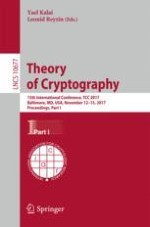2017 | Book
Theory of Cryptography
15th International Conference, TCC 2017, Baltimore, MD, USA, November 12-15, 2017, Proceedings, Part I
Editors: Yael Kalai, Leonid Reyzin
Publisher: Springer International Publishing
Book Series : Lecture Notes in Computer Science
